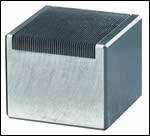Boosting Machine Spindle Speed For Micromachining Applications
Small-diameter micromachining tools require very high rpm for sufficient cutting speed and material removal rates. This air spindle provides 80,000 rpm and an untethered compressed air interface to allow automatic changeovers using the machine's ATC.
Small-diameter end mills and drills used for micromachining require very high rpm to achieve sufficient cutting speed and material removal rates. There are different ways that shops can add high-speed capacity to allow them to machine micromolds, electronic devices, medical parts and other such tiny components. One option is to purchase a dedicated, high speed machining center. A more economical alternative is to use an auxiliary, high speed spindle that installs and operates in a conventional machine’s locked spindle.
Versions of these auxiliary spindles use compressed air as the power source. However, some of these air spindle designs do not lend themselves to automated machining operations. That’s because air lines must be attached manually each time the spindle is loaded into the machine. The RBX air spindle from Big Kaiser Precision Tooling offers adjustable speeds ranging from 30,000 rpm to 80,000 rpm for tools having diameters smaller than 0.06 inch. It also provides an untethered compressed air interface to allow automatic changeovers using the machine’s ATC. When not being used, the air spindle is stored in a tool carousel pocket as would any toolholder.
The RBX is compatible with VMCs that have CAT 40, BT 30 or HSK-A63 spindle tapers. Compressed air is piped through the machine and delivered to a stop block that installs on the machine’s spindle face. When the RBX is loaded into the machine, a position pin slides into the stop block to provide a sealed path for compressed air to reach the air spindle. The air supply is controlled (turned on or off) by M-code, and spindle speed is determined by the air pressure. For example, 60 psi of air pressure delivers 66,000 rpm, while 70 psi will generate approximately 71,000 rpm.
Accurate dynamic runout at high rpm is just as important for micromachining as fast spindle speed. The RBX uses a microcollet system that provides a maximum runout of 1 micron at the nut. The collet nut design has no flats or slots, so vibration at high rpm is reduced (a custom ratcheting wrench that grips the entire periphery of the nut is used to change tools and collets). While the RBX accommodates tool diameters smaller than 0.06 inch, it can clamp shank diameters as big as 0.159 inch. Its microcollets are sized in 0.004-inch increments.
In addition, excessive spindle Z-axis thermal displacement can reduce micromachining accuracy. The RBX’s turbine drive has 1/6 the thermal displacement of a conventional spindle during use, the company says.
Micromachining also presents difficulties recognizing when a cutting tool has broken. Because the RBX air spindle generates less than 65 dB, the noise generated by the cutting tool can be heard giving operators a better chance of determining if a tool has broken.
Related Content
-
GenSwiss Releases Redesigned Toolholding System
Its GenQuick quickchange ER system for Swiss-type CNC machines and precision machining equipment has been updated.
-
Five Common Mistakes Shops Make with ER Collets (And How to Prevent Them)
Collets play a crucial role in the machining process, so proper tool assembly and maintenance is important. Here are five potential pitfalls to avoid when using ER collets.
-
Ceratizit's Updated Tooling Solutions Improve Machining Performance
The company has upgraded its EcoCut indexable inserts lineup, as well as introduced two new toolholding and workholding solutions.

.jpg;width=70;height=70;mode=crop)








.png;maxWidth=300;quality=90)







